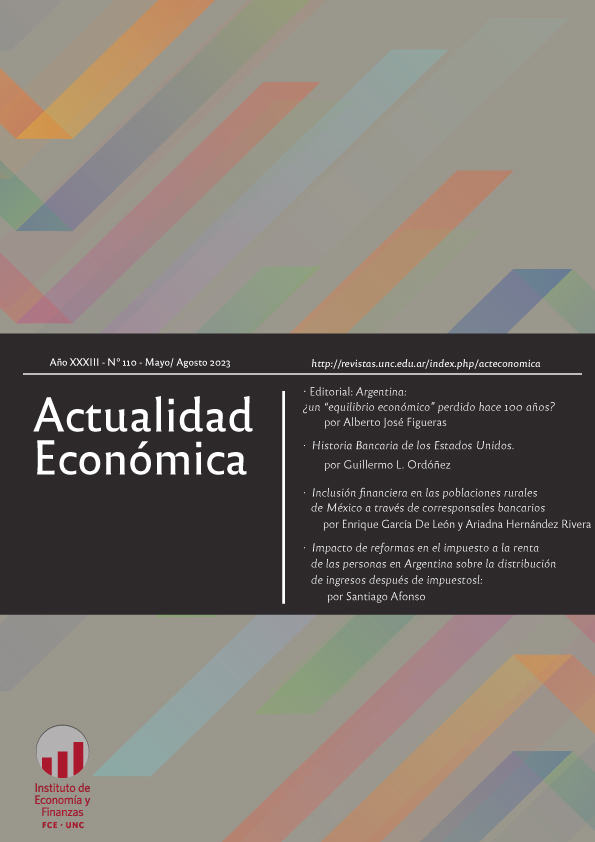Impacto de reformas en el impuesto a la renta de las personas en Argentina sobre la distribución de ingresos después de impuestos
Palabras clave:
Desigualdad del ingreso, Impuesto a la renta, InflaciónResumen
Estudiamos la dinámica de la desigualdad de los ingresos antes y después de impuestos a los ingresos del trabajo personal durante el período que va de 1996 a 2015 en Argentina. Luego de la crisis de 2001-2002, el país observó cambios en la estructura de su economía, en las instituciones del mercado laboral y en las políticas fiscales, con un incremento del peso del sector público en la economía. La trayectoria del impuesto no fue monótona sino dependiente del ciclo político. El documento describe la evolución histórica de los parámetros del tributo y sus principales reformas. Luego empleamos datos administrativos de los empleos en relación de dependencia privados para simular su determinación para cada año y calcular así indicadores de desigualdad. Encontramos una tendencia decreciente de la desigualdad de los ingresos después de impuestos, especialmente sobre el final del período. Las distorsivas reformas al impuesto motivadas por las elecciones generan regresiones limitadas pero perceptibles en los indicadores de desigualdad.
Descargas
Referencias
AFIP. (2020): “Declaración En Línea (Form. 931).,”
Afonso, S. (2023): Diagnóstico del sistema tributario argentino, Working Paper, UNDP.
Afonso, S., and S. Galiani. (2018): “Impuestos en Argentina,” Foco Económico, http://focoeconomico.org/2018/01/17/impuestos-en-argentina/, Accessed 06/20/2021.
Afonso, S., S. Galiani, and M. Tappatá. (2018): La Reforma Tributaria Argentina de 2017,Ministerio de Hacienda, 94.
Allcott, H., B. Lockwood, and D. Taubinsky. (2018): Ramsey Strikes Back: Optimal Commodity Taxes and Redistribution in the Presence of Salience Effects, NBER Working Papers, . NBER Working PapersNational Bureau of Economic Research, Inc, https://ideas.repec.org/p/nbr/nberwo/24233.html.
Alvaredo, F., G. Cruces, and L. Gasparini. (2018): “A short episodic history of income distribution in Argentina,” Latin American Economic Review, 27, 7, DOI:10.1007/s40503-017-0048-3.
Aresco, J. A. (2021): “Estudio de Contexto Sociopolítico AMBA Sobre El Impuesto a Las Ganancias.,”
Atkinson, A. B., and J. E. Stiglitz. (1976): “The design of tax structure: Direct versus indirect taxation,” Journal of Public Economics, 6, 55–75, DOI:10.1016/0047-2727(76)90041-4.
Besley, T., and T. Persson. (2013): “Chapter 2 - Taxation and Development,” in Handbook of Public Economics, ed. by Auerbach, A. J., R. Chetty, M. Feldstein, and E. Saez. . handbook of public economics, vol. 5Elsevier, 51–110, DOI:10.1016/B978-0-444-53759-1.00002-9.
Blanco, J., B. Diaz de Astarloa, A. Drenik, C. Moser, and D. Trupkin. (2021): “The Evolution of the Earnings Distribution in a Volatile Economy: Evidence from Argentina,” CEDLAS Working Papers, , DOI:10.2139/ssrn.3779632.
Cerimelo, M. (2021): “Dinámica de ingresos asalariados en Argentina: un estudio sobre la base de registros administrativos,” CEDLAS Working Papers, , 28.
Díaz Bazán, T. (2011): “Medidas de desigualdad a partir de datos impositivos,”Universidad Nacional de La Plata, DOI:10.35537/10915/31895.
Fernández Felices, D., I. Guardarucci, and J. Puig. (2021): “Incidencia distributiva del sistema tributario argentino,” Estudios económicos, 33, 23–46, DOI:10.52292/j.estudecon.2016.716.
Gasparini, L. C. (1998): “La Incidencia Distributiva Del Sistema Tributario Argentino,” in La Reforma Tributaria en la Argentina, 2 Vol.FIEL.
Gerchunoff, P., and M. Rapetti. (2016): “La economía argentina y su conflicto distributivo estructural (1930-2015),” El Trimestre Económico, 83, 225–72, DOI:10.20430/ete.v83i330.199.
Gómez Sabaini, J. C., J. J. Santieri, and D. A. Rossignolo. (2002): La equidad distributiva y el sistema tributario: un análisis para el caso argentino, . Serie Gestión pública 20Santiago de Chile: Naciones Unidas, CEPAL : Instituto Latinoamericano y del Caribe de Planificación Económica y Social-ILPES, Dirección de Gestión Pública y Regulación.
Jensen, A. (2019): Employment Structure and the Rise of the Modern Tax System,National Bureau of Economic Research, DOI:10.3386/w25502.
Kleven, H. J., and M. Waseem. (2012): “Behavioural Responses to Notches. Evidence from Pakistani Tax Records.,” 58.
Mirrlees, J. A., and S. Adam, eds. (2011): Tax by Design: The Mirrlees Review, Institute for Fiscal Studies.
Observatorio de Empleo y Dinámica Empresarial. (2018): “Manual de La Muestra Longitudinal de Empleo Registrado,”Ministerio de Trabajo, Empleo y Seguridad Social (MTEySS), http://www.trabajo.gob.ar/downloads/estadisticas/basesusuarias/mler/Manual_muestra_longitudinal.pdf.
Rossignolo, D., and J. P. Jiménez. (2019): “Concentración del ingreso y desigualdad según registros tributarios en América Latina: el caso de la Argentina,” 39.
Tommasi, M., and P. T. Spiller. (2007): “The Institutional Foundations of Public Policy in Argentina,” 255.
Tortarolo, D., G. Cruces, and V. Castillo. (2019): It Takes Two to Tango: Labor Responses to an Income Tax Holiday in Argentina, http://economics.dtortarolo.com.ar/jmp-tortarolo.pdf.
Descargas
Publicado
Número
Sección
Licencia

Esta obra está bajo una licencia internacional Creative Commons Atribución-NoComercial-SinDerivadas 4.0.
Aquellos autores/as que tengan publicaciones con esta revista, aceptan los términos siguientes:
- Los autores/as conservarán sus derechos de autor y garantizarán a la revista el derecho de primera publicación de su obra, el cuál estará simultáneamente sujeto a la Licencia Creative Commons Atribución-NoComercial-SinDerivar 4.0 Internacional que permite a terceros compartir la obra siempre que se indique su autor y su primera publicación esta revista.
- Los autores/as podrán adoptar otros acuerdos de licencia no exclusiva de distribución de la versión de la obra publicada (p. ej.: depositarla en un archivo telemático institucional o publicarla en un volumen monográfico) siempre que se indique la publicación inicial en esta revista.
- Se permite y recomienda a los autores/as difundir su obra a través de Internet (p. ej.: en archivos telemáticos institucionales o en su página web) antes y durante el proceso de envío, lo cual puede producir intercambios interesantes y aumentar las citas de la obra publicada. (Véase El efecto del acceso abierto)









